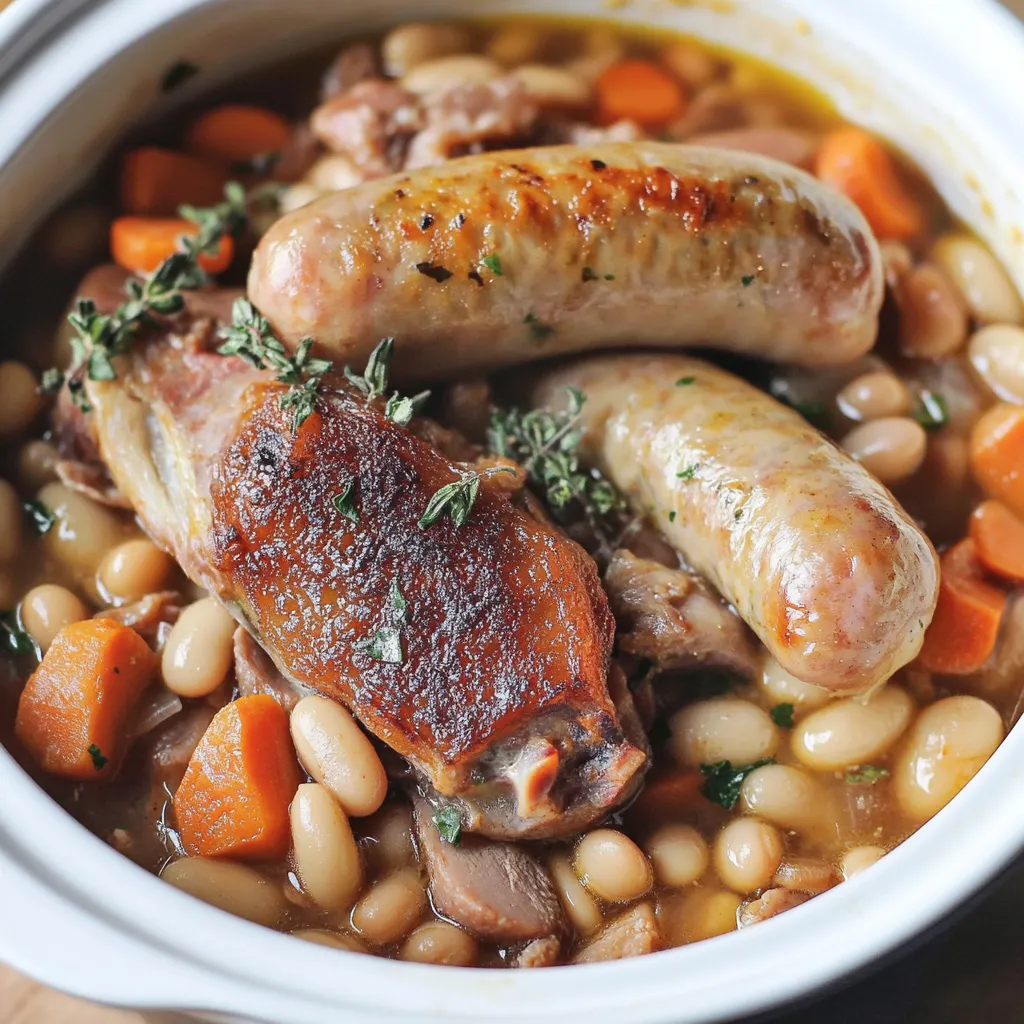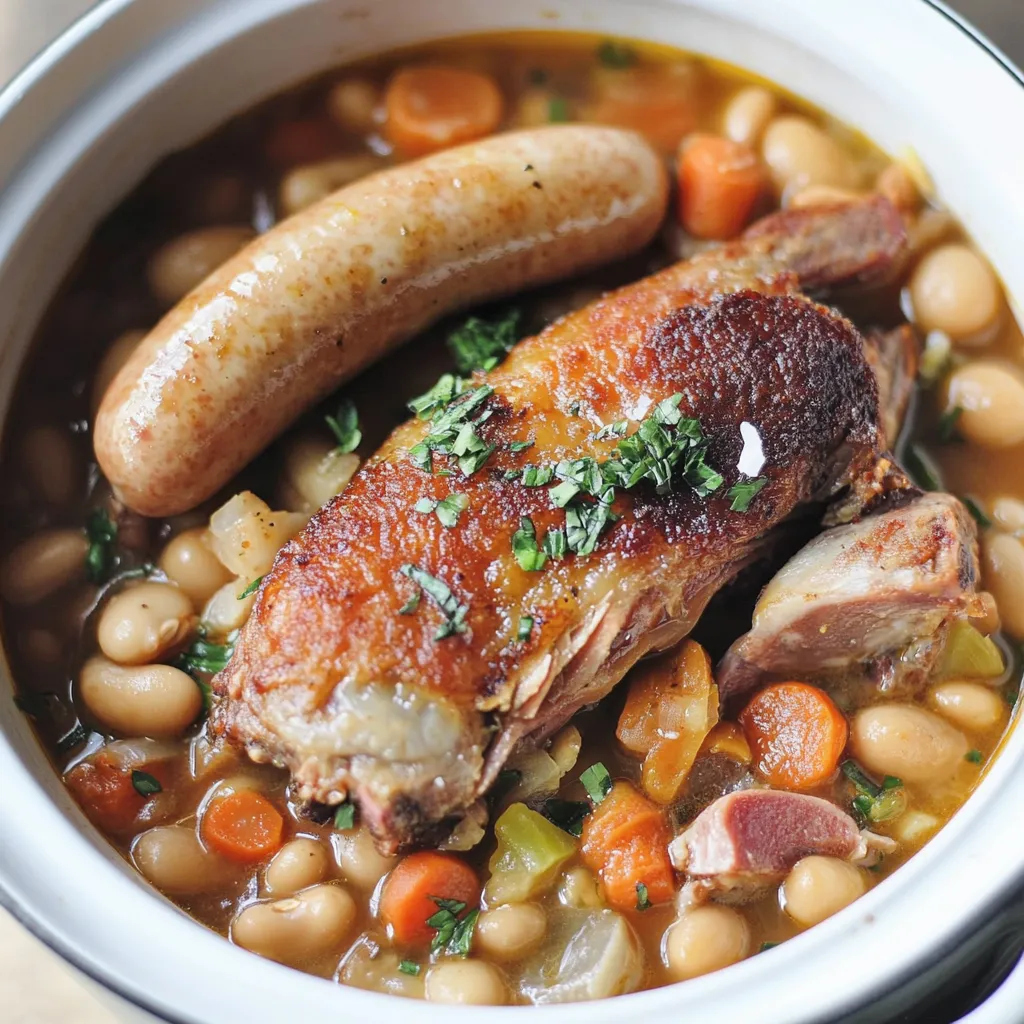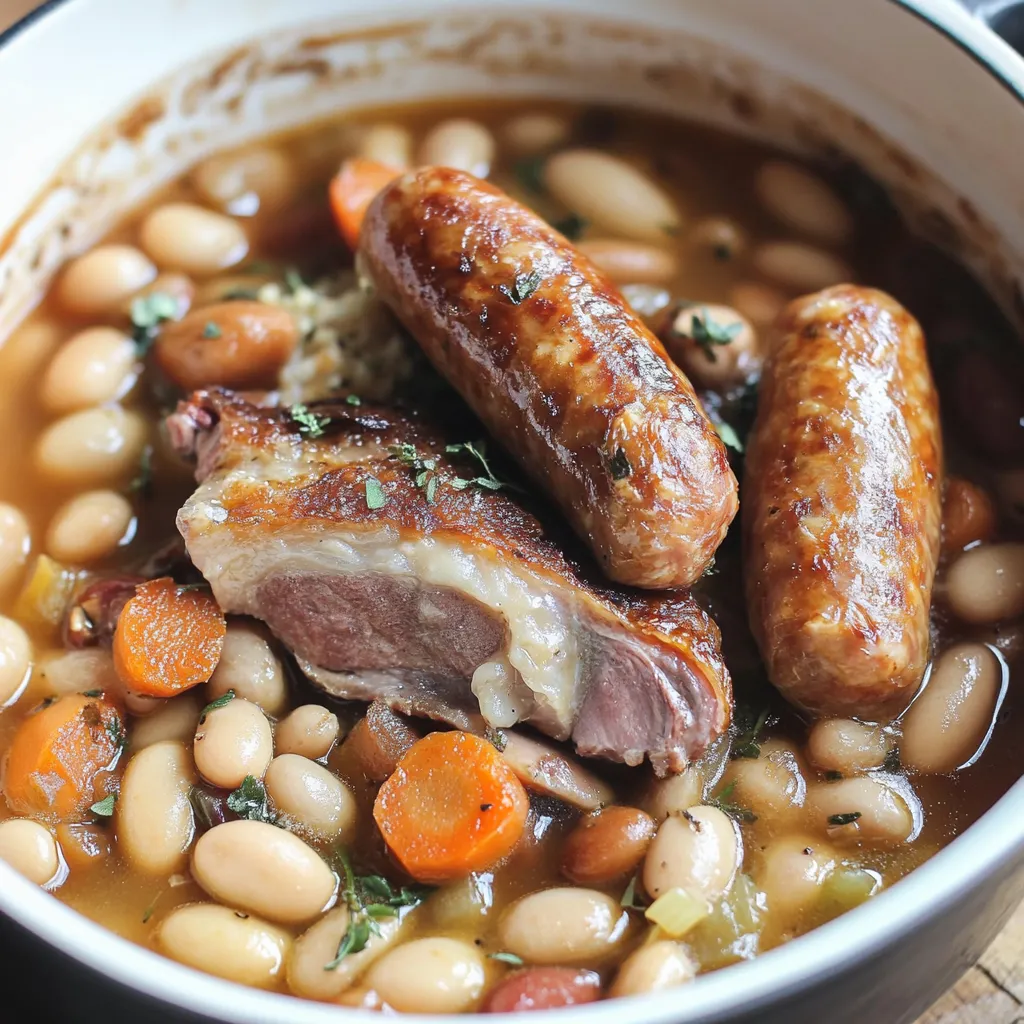 Pin it
Pin it
Slow-cooking white beans with duck confit, sausage, and pork creates one of those French dishes that makes you understand why people travel to eat authentic versions. The beans simmer with aromatic vegetables and herbs until tender, then everything bakes together in the oven where the top develops a golden crust while the inside stays creamy and rich. Duck confit adds luxurious flavor you can't replicate with regular chicken, and chunks of pork belly render their fat throughout, enriching every spoonful. This takes time and patience but rewards you with a pot of comfort food that tastes like generations of French grandmothers perfected it.
French cooking intimidated me until I realized cassoulet is basically just fancy beans with meat. My first attempt happened after finding duck confit at a specialty store and deciding to finally try making this dish I'd only eaten in restaurants. That first pot took all day but tasted so incredible that I understood why cassoulet inspires such devotion. The combination of creamy beans, rich duck, and savory pork creates flavors that keep you going back for another spoonful even when you're completely full. Now I make this every winter when I want something special that fills the house with amazing smells for hours.
Ingredients and Why They Matter
- Duck confit legs (4-6 pieces): Pre-cooked duck preserved in its own fat; the traditional protein that defines cassoulet with no real substitute
- Dried Great Northern or flageolet beans (1 pound): Must be dried, not canned, because they need to cook slowly and absorb flavors; flageolets are traditional French beans
- Yellow onions (2 large, diced): Browning these properly creates the sweet, caramelized base that makes cassoulet special
- Celery (3 stalks, diced): Aromatic vegetable that adds depth
- Carrots (2 medium, diced): Natural sweetness and color
- Garlic (6 cloves, minced): Essential aromatic that builds flavor
- Fresh herbs (parsley, thyme sprigs, bay leaves): Bundle these into bouquet garni for easy removal; dried herbs don't provide the same fresh flavor
- Pork belly (8 ounces, cut into chunks): Renders fat that enriches the beans; pancetta or thick-cut bacon substitute
- Toulouse or garlic sausage (1 pound): Traditional French sausage adds garlicky flavor; Italian sausage works but avoid fennel-heavy versions
- Dry white wine (1 cup): Chardonnay or Pinot Grigio deglaze the pot and add acidity; don't use sweet wine
- Chicken or vegetable stock (6 cups): Liquid for cooking beans; homemade tastes best but store-bought works
- Cherry tomatoes (1 cup quartered): Fresh tomatoes add acidity; canned whole tomatoes or tomato paste substitute
- Salt and black pepper (to taste): Essential for seasoning the beans properly
- Duck fat or olive oil (2-3 tablespoons): For browning meats; duck fat adds more flavor
How To Make It
- Soak the beans overnight:
- Place your dried beans in a large container or bowl and cover them with cold water by at least 4-6 inches. The beans will expand significantly as they absorb water, so make sure you use plenty. Cover the container and let the beans soak at room temperature for at least 12 hours, though up to 24 hours works fine. This soaking rehydrates the beans and reduces cooking time while creating more even texture. If you forget to soak overnight, cover beans with boiling water and let sit for 1 hour as a quick-soak alternative. The next day, drain and rinse the soaked beans in a colander. Don't skip soaking because unsoaked beans would take much longer to cook and might never become properly tender.
- Brown the pork:
- Heat a large Dutch oven or enameled cast iron pot over medium-low heat. Add 2 tablespoons of duck fat or olive oil and let it warm. Add your pork belly chunks or bacon pieces in a single layer. Cook slowly for 12-15 minutes, turning occasionally, until the pork develops light golden color on all sides and renders some of its fat into the pot. You're not trying to crisp it completely, just develop color and start the fat rendering process. The rendered fat will help flavor everything else. Transfer the browned pork to a plate using a slotted spoon, leaving the fat in the pot. Don't clean the pot because those browned bits add flavor.
- Sear the sausages:
- Increase heat to medium and add the sausages to the same pot with the pork fat. Sear for 3-4 minutes per side until they develop nice brown color all over. They don't need to cook through completely because they'll finish in the oven later. You're just building flavor through browning. Transfer seared sausages to the plate with the pork. Again, leave all that flavorful fat and browned bits in the pot for the next steps.
- Caramelize the onions:
- This step requires patience but makes tremendous difference in final flavor. Add your diced onions to the pot with all that accumulated fat. Reduce heat to low-medium and cook for 25-30 minutes, stirring every 5-7 minutes. Don't rush this by using higher heat because you want slow, even browning that develops deep sweetness without burning. The onions will gradually shrink, turn golden, then develop rich brown color. They should be very soft and caramelized when done. This long cooking transforms sharp onion flavor into mellow sweetness that forms the flavor foundation of great cassoulet.
- Add vegetables and aromatics:
- Once onions are properly browned, add the diced carrots and celery to the pot. Increase heat to medium and sauté for 2-3 minutes, stirring frequently, until the vegetables start softening. Add the minced garlic and cook for just 30-45 seconds, stirring constantly, until fragrant. Don't let the garlic burn or it turns bitter. Add the quartered tomatoes and cook for 1 minute more, stirring to combine everything. The tomatoes will start breaking down and releasing their juices.
- Deglaze with wine:
- Pour the white wine into the pot, using a wooden spoon to scrape up all those flavorful browned bits stuck to the bottom. This process is called deglazing and captures tremendous flavor that would otherwise be wasted. Let the wine cook for a few minutes until most of it has evaporated or been absorbed by the vegetables. A few tablespoons of liquid remaining is fine. The alcohol will cook off, leaving just the wine's acidity and depth.
- Simmer the beans:
- Drain your soaked beans and add them to the pot along with the browned pork pieces, chicken stock, and your bundle of fresh herbs tied together with kitchen string. Season generously with salt and pepper. Bring everything to a boil over high heat, then immediately reduce to low, cover with a lid, and maintain a gentle simmer. Cook for about 1 hour, checking occasionally, until the beans are just tender but not mushy. They should still hold their shape but be creamy inside when you bite one. The beans will continue cooking in the oven later, so don't overcook them now.
- Assemble and bake:
- Preheat your oven to 375°F. Remove the lid from your pot. Cut the sausages into large pieces if desired, or leave them whole. Nestle the sausage pieces and duck confit legs down into the beans, pressing them slightly so they're partially submerged but still visible on top. You want the meats distributed throughout rather than all sitting on the surface. Place the uncovered pot in the oven on a rack in the lower third position. Bake for 1½ to 2 hours. During baking, a golden crust will form on top from proteins and starches browning. If crust forms quickly, you can gently fold it back into the beans every 30 minutes to distribute that concentrated flavor throughout. Otherwise, leave it alone and let it develop into a crunchy top layer.
- Serve:
- Remove the cassoulet from the oven when the top is golden brown and crusty, the beans are creamy and tender, and everything looks rich and bubbling. Let it rest for 10-15 minutes before serving so it's not molten hot. Serve directly from the pot at the table for rustic presentation, or ladle portions into individual shallow bowls. Make sure each serving includes beans, vegetables, pieces of pork, sausage, and duck. The beans should be creamy with a rich, meaty broth coating everything. Crusty bread on the side is essential for soaking up all that flavorful liquid.
 Pin it
Pin it
Duck confit became less intimidating after I learned you can buy it already prepared at specialty stores or online. Making confit from scratch requires curing duck legs in salt, then cooking them submerged in duck fat for hours - not impossible but definitely advanced. The pre-made versions taste excellent and eliminate an entire day of work. My first cassoulet used regular duck legs instead of confit and tasted good but lacked that signature richness. Once I tried it with real confit, I understood why people insist on using the traditional ingredient.
The Cassoulet Tradition
Cassoulet originated in southern France as peasant food that used inexpensive ingredients and long, slow cooking to create something substantial and delicious. Different regions claim their version as the most authentic - Castelnaudary, Carcassonne, and Toulouse all have their own traditions. Castelnaudary uses duck confit and pork. Carcassonne adds lamb. Toulouse includes both duck and Toulouse sausage. Despite these variations, all cassoulets share the common elements of white beans, pork, and long cooking. The dish got its name from the **cassole**, a traditional earthenware pot with sloping sides that increases surface area for crust formation.
Bean Selection Importance
Using the right beans dramatically affects final texture and flavor. **Great Northern beans** are widely available in American supermarkets and work beautifully, holding their shape while becoming creamy inside. **Flageolet beans** are traditional French beans that stay firmer with a slightly nutty flavor. White kidney beans work in a pinch but don't have quite the same texture. Never use canned beans because they're already fully cooked and would disintegrate during the extended oven baking. Dried beans need that long cooking to properly absorb the rich flavors from duck fat, pork, aromatics, and stock. Properly cooked cassoulet beans should be tender and creamy but still hold their shape with distinct individual beans visible.
Layering Flavors
Cassoulet's incredible depth comes from building flavors in stages. Browning pork renders fat and creates fond. Searing sausages adds more browning and flavor. Caramelizing onions develops sweetness. Sautéing vegetables and garlic builds aromatic base. Deglazing with wine captures all those browned bits. Simmering beans in stock infuses them with savory richness. Baking everything together allows flavors to meld and concentrate. Each step contributes something essential to the final dish. Skipping steps or rushing any of them produces inferior results compared to following the full process patiently.
The Fond Question
During oven baking, proteins and starches rise to the surface and brown, forming a crust called **fond**. Some cooks prefer folding this crust back into the beans every 30 minutes, distributing concentrated flavor throughout. Others leave it undisturbed to develop a thick, crunchy top layer that contrasts with creamy beans below. Both approaches work - it's personal preference. Traditional cassoulet often includes breadcrumbs mixed with olive oil sprinkled on top before baking, creating additional crunch. This isn't essential but adds textural interest if you want it.
Make-Ahead Benefits
Cassoulet's flavors improve significantly after sitting, making it ideal for preparing a day ahead. Cook everything completely, cool to room temperature, cover, and refrigerate overnight. The next day, reheat gently in a 350°F oven for 30-40 minutes until heated through. You may need to add splash of stock if it seems dry. The overnight rest allows all those complex flavors to meld and mellow, creating even more harmonious taste. Many cooks insist cassoulet is actually better on day two or three than freshly made. This quality makes it perfect for entertaining since all the work happens in advance.
Serving Suggestions
Cassoulet is substantial enough to serve as a complete meal needing only bread and perhaps salad. Crusty French bread or baguette is essential for soaking up the rich, meaty broth. A simple green salad with vinaigrette provides fresh contrast to the rich beans. Roasted or steamed green beans add color. A glass of red wine - perhaps the same wine you'd drink in southwestern France - complements the dish perfectly. Serve in shallow bowls or directly from the pot for rustic, family-style dining. Cassoulet is meant to be hearty and filling, so portions don't need to be huge.
 Pin it
Pin it
This duck cassoulet represents French country cooking at its finest - simple ingredients transformed through patient technique into something extraordinary. The long cooking time mostly involves waiting while the oven or stovetop does the work, making this more approachable than the ingredient list suggests. When you serve a pot of this with its golden crust, tender beans, rich meats, and incredible aromas, it feels like a special occasion meal worthy of celebration. Sometimes the best recipes are the ones that connect you to culinary traditions spanning generations, and cassoulet absolutely delivers that experience along with deeply satisfying flavors that justify every minute of cooking time.
Frequently Asked Questions
- → Can I use canned beans instead of dried beans?
- No, dried beans are necessary for this recipe. Canned beans won't give you the right texture and will fall apart during the long cooking process.
- → What if I don't have time to soak beans overnight?
- You can do a quick soak by covering the beans with boiling water and letting them sit for 1 hour before using them in the recipe.
- → Where can I find duck confit?
- Duck confit is available at specialty grocery stores, butcher shops, or online. Some larger supermarkets carry it in the gourmet or frozen section.
- → Can I make cassoulet ahead of time?
- Yes, you can refrigerate it for 4-5 days or freeze it for up to 3 months. Reheat with a bit of chicken stock to keep it moist.
- → What type of sausage works best?
- Traditional cassoulet uses French Toulouse sausage, but any good quality pork sausage with herbs will work well in this recipe.
- → Do I need a special pot for this?
- A large Dutch oven that can go from stovetop to oven works perfectly. An 8-quart size is ideal for this amount of cassoulet.
- → Why do the onions need to cook for so long?
- Slowly caramelizing the onions for 25-30 minutes develops deep, sweet flavors that form the flavor base of the entire dish.
